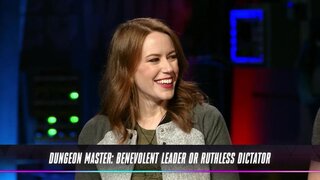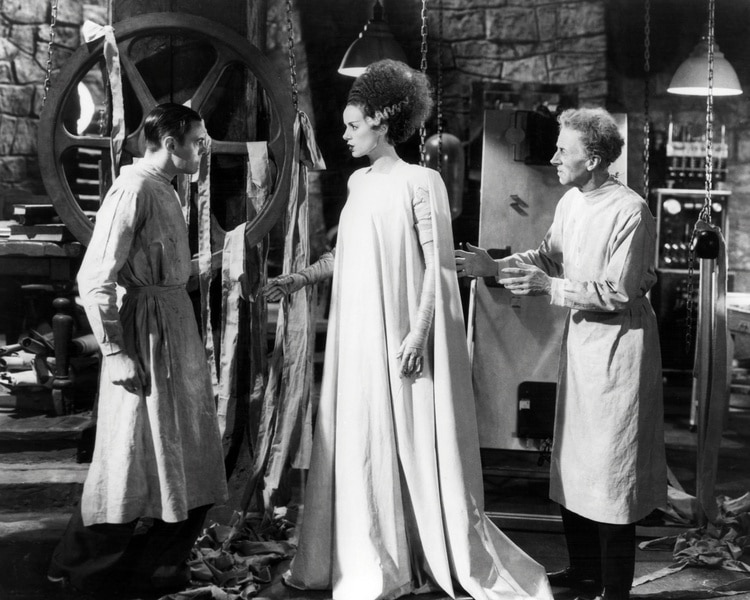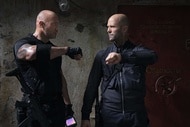Create a free profile to get unlimited access to exclusive videos, sweepstakes, and more!
What Are the Differences Between the Frankenstein Films and Mary Shelley’s Novel?
Some fan favorite characters from the Universal Monster classic Frankenstein didn’t even exist in the book!
Say the name “Frankenstein” and a specific image likely comes to mind. That popular conception of Frankenstein’s monster comes less from Mary Shelley’s original 1818 novel, and more from the iconic films produced by Universal Pictures.
In the 1930s and 1940s, Universal released eight feature films featuring Frankenstein’s monster. While there have been numerous adaptations of Frankenstein since, those classic Universal Monster films still loom large as arguably the definitive version of the tale. However, many of those films, while considered horror classics, have almost nothing to do with Shelley’s gothic masterpiece, particularly the later “monster rally” pictures, which threw together Frankenstein’s monster, Count Dracula, the Wolf Man, and more in crossover stories.
Only the first two Universal Frankenstein films, the 1931 original (streaming on Peacock here) and 1935's Bride of Frankenstein (streaming on Peacock here), both directed by James Whale, have plots directly based on Shelley’s novel. So what exactly changed between the beloved novel and the classic movies?
How Frankenstein's Monster is different from the book to the movies
The monster in the films, portrayed by Boris Karloff in the first three installments, has a square head, heavy brow, and bolts in his neck. He is often thought to have green skin but was likely just meant to be pale – greenish makeup appeared lighter in black-and-white film stock. The creature of Shelley’s novel is described as having “flowing” black hair, “beautiful” features, and yellowed skin. The version from the 2004 Hallmark Channel miniseries – streaming now on Peacock – is closer to the novel.
Shelley also describes the creature as being more than 8 feet tall, a consequence of Frankenstein’s desire to create something superhuman. While Karloff strikes an imposing figure, the actor was around 6 feet tall in height, though enhanced in stature with platform boots. Karloff’s creature has a slow, stiff gait; Shelley’s is not just stronger, but more flexible and faster than a human.
In the film, the monster is brought to life through a dramatic process, involving Frankenstein elevating his creation through a skylight and harnessing the power of lightning. In the novel, the creature’s birth is less dramatic, gasping to life once Frankenstein has put all his pieces in place.
The film’s monster also has a vastly different personality from the one in the novel. Though he develops across his appearances, the creature begins inarticulate and confused, mostly speaking in grunts and only rarely reaching short sentences. In the novel, the creature is extremely intelligent and calculating. He is not just able to speak, but is highly verbose, delivering flowery monologues describing his isolation and the conundrum of his existence.
Dr. Frankenstein's name and personality
In the novel, the titular doctor is Victor Frankenstein, while in the films, he’s named Henry. It seems he’s swapped names with his best friend, as in the novel, Victor Frankenstein’s friend is named Henry. In the film, Henry Frankenstein’s friend is named Victor.
Colin Clive’s Henry Frankenstein is iconic and laid the foundation for the mad scientist archetype. He has a manic energy and a penchant for iconic quotes, from “it’s alive!” to “now I know what it feels like to be God!” By contrast, the novel’s Frankenstein is a gloomier figure, who fears and despises his creation and feels immense guilt for his actions.
Igor was created for the Frankenstein movies... kind of
Igor, Frankenstein’s hunchbacked assistant, is a recognizable pop culture figure, but such a character doesn’t actually appear in either the novel or the original Universal films. In the novel, Frankenstein works alone, keeping his work secret. In the film, Frankenstein has an assistant, portrayed by Dwight Frye — but he’s named Fritz, not Igor. The misconception may come from viewers confusing Frye’s Fritz with the sinister Ygor (with a y!) played by Dracula star Bela Lugosi in Son of Frankenstein (streaming on Peacock here) and The Ghost of Frankenstein.
Another Frankenstein character invented for the movies
Dr. Pretorius (Ernest Thesiger) is one of the most memorable characters in Bride of Frankenstein. Thesiger’s performance is delightfully campy and sinister, and Pretorius is crucial to the plot as the one who convinces Frankenstein to craft a companion for his monster. However, like Fritz, Pretorius is a filmic invention. Frankenstein has no comparable mentor figure in the novel, though the Monster's manipulative personality may have inspired Pretorius.
Here comes the Bride of Frankenstein
The titular Bride of Frankenstein, made iconic in only a few minutes of screen time by Elsa Lanchester, is another invention of the films, though one rooted in the novel. In both Shelley’s novel and Whale’s film, Frankenstein is compelled to make a female counterpart to his creature. In the novel, the creature demands Frankenstein make him a mate; in the film, it’s an idea from Pretorius.
In the novel, Frankenstein doesn’t go through with it, destroying the nearly complete bride amid fears that his creations would reproduce and unleash a race of monsters on the world. The creature vows vengeance on his creator for dooming him to solitude and exacts his revenge by murdering Frankenstein’s fiancée, culminating in a chase to the Arctic Circle.
RELATED: Epic Universe Team Teases Park As Immersive Sequels to Beloved Universal Movies
In the film, the Bride is successfully brought to life. However, she fears and despises the Monster, hissing and shrieking at him. This triggers the Monster to believe he will never find acceptance. He forlornly pulls a level to destroy Frankenstein’s laboratory, killing himself, the Bride, and Pretorius, while imploring Frankenstein and his wife Elizabeth to leave and get a fresh start.
Both Shelley’s 1818 novel and Whale’s 1930s films are masterpieces and cultural icons. But despite sharing a title and many elements, they’re very much their own thing. If you’ve seen the movie, you haven’t read the book; if you’ve read the book, you haven’t seen the movie. Really, you should do both.
Frankenstein, Bride of Frankenstein, Son of Frankenstein, and more Universal Monsters favorites are streaming now on Peacock.
































